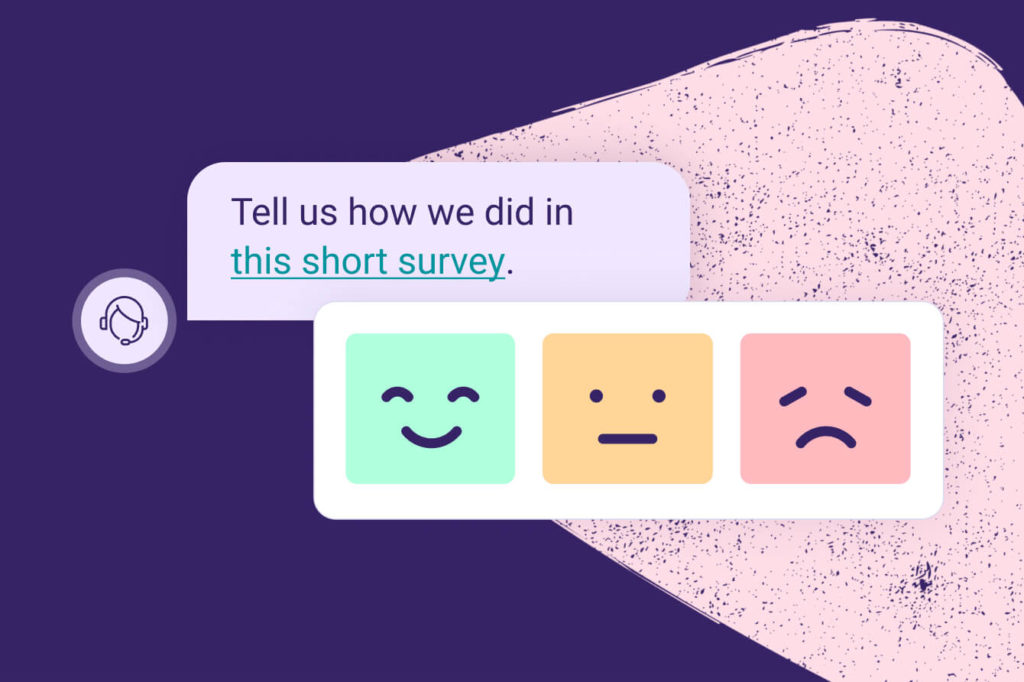You know that business success hinges on listening to customers, understanding their wants and needs, and taking action to meet those needs.
That’s pretty straightforward business talk.
But while 72% of CEOs say they have a pretty good handle on who their customers are and what they want, only 35% of consumers feel the same way—highlighting a massive perception gap in the customer experience and setting brands up for dangerous dips in sales and retention.
So what’s to blame? Mis-focused metrics? Faulty feedback processes? While a number of factors might play a role, we’d argue that the disconnect stems from a fundamental misunderstanding of voice of the customer (VoC).
From exploring its definition to showing how it’s different from other CX metrics out there, here’s a framework that’ll help your brand develop a crystal clear understanding on what it means to holistically listen to and serve your customers so they’ll stick around for the long haul.
VoC defined
At its core, voice of the customer is all about holistically understanding your customers on both an individual and collective basis. VoC accounts for customers’ thoughts, feelings, words, and behavior at every stage of their journey, then—when collected and analyzed properly—provides brands with a roadmap to improve their products, services, and customer experience as a whole.
So in practice, voice of the customer is knowing, analyzing, and acting on the thoughts, feelings, words, and behaviors of your customers.
Now you might be thinking: I already measure this with our CSAT or NPS surveys…that’s all we’re talking about here, right?
Not quite.
We’ll break down how VoC specifically differs from other CX and feedback metrics down below. But first, here are some standout characteristics of VoC that make it mission critical for every enterprise business.
VoC accounts for the entire customer experience.
Think of VoC like an umbrella. While CSAT, NPS, CES, and other CX metrics might give you a glimpse into singular aspects of your customers’ experience, VoC accounts for every aspect to provide brands with a holistic picture of their customers. This requires collecting and analyzing direct and indirect feedback at every stage of a customers’ journey—not just post-interaction or post-purchase.
This should lead to asking questions like:
- How do customers feel when they first encounter your brand?
- What are their thoughts when interacting with your marketing material?
- How do they feel while interacting with your sales or support team?
- What is their buying experience like?
- What steps do they take on your website or app?
- How likely are they to do business with your company again?
These questions are both qualitative and quantitative, making them excellent at truly uncovering the voice of your customers.
VoC considers both individual and collective feedback.
Aggregated data is great when you want a 10,000-foot-flyby of your customers’ experience with your brand. But relying solely on aggregated data can quickly depersonalize your interactions with individual customers—ensuring they feel neither heard or understood. It’s like losing the trees for the forest.
A well-established VoC program accomplishes the best of both worlds: helping brands keep a finger on the pulse of their overall customer experience through metric-based feedback (like CSAT, NPS, and CES) while also engaging customers on an individualized basis. This requires a flexible, channel-agnostic feedback solution in place that empowers reps to quickly and effectively respond to individual customer feedback—letting customers know that you heard their feedback and are using it to improve their experience.
VoC requires buy-in from the entire company.
VoC isn’t just another metric or element that lives with your support or marketing teams. For a VoC program to truly be effective, every individual, team, and department—from the C-suite to the service department—needs to be on the same page if they plan on effectively serving customers and exceeding their expectations.
- C-suite execs need to know their customers’ pain points so they can make stronger, customer-driven business decisions.
- Product and development teams need clear customer feedback on what works and what needs to be improved so they can create stronger products and offerings.
- Marketing teams need to know which channels resonate the most with their customers so they can sharpen their messaging and marketing spend.
- Support and service teams need to hear about customer friction points so they can smooth out the customer experience at every stage of the customer journey.
Understanding and acting on VoC truly is a group effort.
How does VoC fit with other key CX metrics?
Let’s face it: you’re likely already swimming in CX metrics. CSAT, NPS, CES, and a slough of other mission critical acronyms. So where does VoC come in? Or better yet, if you’re already measuring CSAT, NPS, and CES, then aren’t you already measuring VoC?
Yes and no.
It’s really another form of the old is-a-square-a-rectangle debacle. On one hand, quantitative metrics are considered part of VoC. But on the other hand, VoC is more than just quantitative metrics.
To get VoC right, we need to be crystal clear on how it’s different from other metrics and the action steps brands need to take to measure it accurately.
The difference between VoC and CSAT
Customer Satisfaction (CSAT) is often considered the end-all-be-all of the customer experience. After all, if a customer isn’t satisfied with your service or product, they’re not likely to come back. However, CSAT can only provide a limited window into what your customers are actually thinking about your brand. And that’s where CSAT and VoC differ.
For one, CSAT is usually based on quantitative, five-to-ten question surveys that come after a customer has interacted with a brand or made a purchase. You’re familiar with the standard questions: on a scale of 1-5…
- how would you rate your interaction or purchase today?
- how satisfied were you with the support agent?
- how well does our product meet your expectations and needs?
Now, we’re not advocating throwing the baby out with the bathwater. CSAT questions directly contribute to VoC by helping define overall customer sentiment. But where CSAT questions often fall short is their ability to provide deeper insights into the customer experience itself.
A strong VoC program requires supplementing CSAT data with qualitative data. A couple ways of doing this could look like:
- Experimenting with different survey questions and distribution channels to see where customers provide the most feedback data.
- Using an AI-empowered feedback tool to flag negative CSAT responses for direct followup from an agent.
- Conducting one-on-one interviews or focus groups with current customers and potential prospects.
Holistic approaches like these dig deeper than standard CSAT surveys—giving brands a stronger picture of who their customers are and how they can better serve them.
Another bonus this qualitative data provides is the ability brands have to compare it with standard CSAT and CCaaS metrics so they can identify CX outliers without making assumptions. Take for example a customer who gives a two out of five on a CSAT question. With a blend of qualitative and quantitative data, the CX team could see that her frustration came from having to wait 10+ minutes in a hold queue and her total talk time was over 20 minutes.
The difference between VoC and NPS
Net Promoter Scores (NPS) shows just how likely a customer is to recommend your brand, services, and products to those around them. That’s obviously a huge win for your business. But since NPS is often measured by a single question on a 0-10 scale, it can’t provide brands with a clear picture on why a customer is more likely to spread positive vibes about your brand.
Again, VoC serves as a customer and market research method rather than just a single viewpoint into a customer’s experience. So, like CSAT, a VoC program digs into the why behind a customer’s positive (or negative) NPS score.
Here’s a few ways to supercharge your NPS surveys to generate stronger VoC data:
- Ditch the ultra-generic, company-wide NPS question and ask about something specific instead, like how likely they are to recommend one of your products or services.
- Add one or two more questions to your standard NPS survey, like:
- “What was missing or disappointing in your experience with our brand?”
- “What do you like/dislike the most about our company?”
- “How could we make you happier as a customer?”
- Similar to a CSAT survey, use AI to flag negative NPS scores for a followup interview from a customer service representative.
Next steps
While it’s far from rocket science, getting a crystal clear picture of who your customers are and what makes them tick doesn’t happen overnight. It requires organizational alignment, a flexible voice of customer solution, and a definitive action plan for closing the loop with customers and putting their feedback to work.
But don’t let the process keep you from getting started. Remember, the name of the game for VoC is qualitative. Start by identifying how you’re currently collecting VoC data (in the form of CSAT, NPS, and CES), then consider how you can tweak those processes to capture more qualitative data. Rewrite questions, distribute surveys in customer-preferred channels to boost your response rate, then talk with department stakeholders on how you can better incorporate that data into your current processes.





